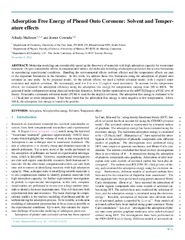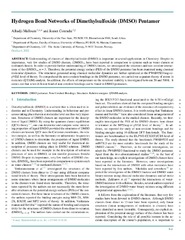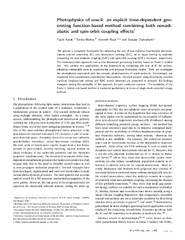Artikler, rapporter og annet (kjemi): Recent submissions
Now showing items 1-20 of 538
-
Electronic Structure of Metallophlorins: Lessons from Iridium and Gold Phlorin Derivatives
(Journal article; Tidsskriftartikkel; Peer reviewed, 2024-05-14)Phlorins have long remained underexplored relative to their fully conjugated counterparts, such as porphyrins, hydroporphyrins, and corroles. Herein, we have attempted to bridge that knowledge gap with a scalar-relativistic density functional theory (DFT) study of unsubstituted iridium and gold phlorin derivatives and a multitechnique experimental study of iridium-bispyridine and gold complexes of ... -
Kinetically-Controlled Ni-Catalyzed Direct Carboxylation of Unactivated Secondary Alkyl Bromides without Chain Walking
(Journal article; Tidsskriftartikkel; Peer reviewed, 2024-01-09)Herein, we report the direct carboxylation of unactivated secondary alkyl bromides enabled by the merger of photoredox and nickel catalysis, a previously inaccessible endeavor in the carboxylation arena. Site-selectivity is dictated by a kinetically controlled insertion of CO<sub>2</sub> at the initial C(sp<sup>3</sup> )−Br site by the rapid formation of Ni(I)−alkyl species, thus avoiding undesired ... -
Synthesis of Cryptophanes: Recent Advances
(Journal article; Tidsskriftartikkel; Peer reviewed, 2023-12-28)This review covers the latest developments in the synthesis of cryptophane host molecules since the publication of the last extensive review by Brotin and Dutasta in 2009. The literature has been categorized according to the synthetic method for generating the cryptophane core and we also emphasize emerging late-stage functionalization approaches. The synthetic strategies towards cryptophanes ... -
VAMPyR—A high-level Python library for mathematical operations in a multiwavelet representation
(Journal article; Tidsskriftartikkel; Peer reviewed, 2024-04-26)Wavelets and multiwavelets have lately been adopted in quantum chemistry to overcome challenges presented by the two main families of basis sets: Gaussian atomic orbitals and plane waves. In addition to their numerical advantages (high precision, locality, fast algorithms for operator application, linear scaling with respect to system size, to mention a few), they provide a framework that narrows ... -
Asymmetric Boracarboxylation of Styrenes Using Carbon Dioxide
(Journal article; Tidsskriftartikkel; Peer reviewed, 2024-04-22)The boracarboxylation reaction has potential for the production of natural products and drug candidates, but the development of an asymmetric version of this transformation is challenging. We report an enantioselective boracarboxylation of styrenes, enabled by a copper catalyst containing chiral phosphines. Our experimental conditions provide yields between 31–76% and enantiomeric ratios from ... -
Hypsochlorins
(Journal article; Tidsskriftartikkel; Peer reviewed, 2024-03-19)Both the Soret and Q bands of chlorin e6 complexes blueshift on going from Zn to Pd to Pt as the coordinated metal, establishing the latter two complexes as hypsochlorins. DFT/TDDFT calculations indicate that the blueshifts appear to be related to the presence of the electronegative metal ion, which lowers the orbital energies of the HOMO and HOMO-1, while leaving the LUMOs relatively unaffected. -
Theoretical Photoelectron Spectroscopy of Metal-Metal Quintuple Bonds: Relativity-Driven Reordering of Frontier Orbitals
(Journal article; Tidsskriftartikkel; Peer reviewed, 2024-03-01)A recent reinvestigation of the gas-phase photoelectron spectra of Group 6 metal−metal quadruple-bonded complexes with scalar-relativistic DFT calculations showed that common exchange-correlation functionals reproduce the lowest ionization potentials in a semiquantitative manner. The finding encouraged us to undertake a DFT study of metal− metal quintuple bonds in a set of bisamidinato complexes ... -
Exploring the Frozen Armory: Antiphage Defense Systems in Cold-Adapted Bacteria with a Focus on CRISPR-Cas Systems
(Journal article; Tidsskriftartikkel; Peer reviewed, 2024-05-20)Our understanding of the antiphage defense system arsenal in bacteria is rapidly expanding, but little is known about its occurrence in cold-adapted bacteria. In this study, we aim to shed light on the prevalence and distribution of antiphage defense systems in cold-adapted bacteria, with a focus on CRISPR-Cas systems. Using bioinformatics tools, Prokaryotic Antiviral Defense LOCator (PADLOC) and ... -
Theoretical Photoelectron Spectroscopy of Quadruple-Bonded Dimolybdenum(II,II) and Ditungsten(II,II) Paddlewheel Complexes: Performance of Common Density Functional Theory Methods
(Journal article; Tidsskriftartikkel; Peer reviewed, 2024-03-03)We have revisited the gas-phase photoelectron spectra of quadruplebonded dimolybdenum(II,II) and ditungsten(II,II) paddlewheel complexes with modern density functional theory methods and obtained valuable calibration of four well-known exchange−correlation functionals, namely, BP86, OLYP, B3LYP*, and B3LYP. All four functionals were found to perform comparably, with discrepancies between calculated ... -
Inverse Photoemission Spectroscopy of Coinage Metal Corroles: Comparison with Solution-Phase Electrochemistry
(Journal article; Tidsskriftartikkel; Peer reviewed, 2024-06-19)A combined direct and inverse photoemission study of coinage metal corroles suggests that the latter technique, in favorable cases, can provide some additional information relative to electrochemical measurements. Thus, whereas inverse photoemission spectroscopy (IPES) provides relative electron affinities for electron addition to different unoccupied orbitals, electrochemical reduction potentials ... -
Rethinking gold(II) porphyrins: an inherent wave distortion
(Journal article; Tidsskriftartikkel; Peer reviewed, 2024-01-23)Relativistic DFT (OLYP-D3/ZORA-STO-TZ2P) calculations predict low adiabatic ionization potentials for gold(II) porphyrins, from 4.60 eV for Au[TPP] (TPP = tetraphenylporphyrin) to 5.34 eV for Au[TPFPP] [TPFPP = tetrakis(pentafluorophenyl)porphyrin]. These values are over 1 eV lower than those calculated for analogous silver(II) porphyrins, reflecting much greater relativistic destabilization of ... -
Hvem bør ha ansvar for kjemilab?
(Preprint; Manuskript, 2024-05-14)Mange ulike studieprogram har et innføringsemne i kjemi, ofte i første studieåret. Et slikt kjemiemne inkluderer vanligvis laboratorieundervisning, som er ressurskrevende å gjennomføre for et stort antall (flere hundre) studenter. Det er vanlig at instituttet som har ansvar for emnet også har ansvar for laboratorieundervisningen. Dermed får studentene på ulike studieprogram samme labøvelser av samme ... -
DFT and electrochemical study on some iron(III) complexes with 2-hydroxybenzophenones
(Journal article; Tidsskriftartikkel; Peer reviewed, 2023-02-17)The synthesis, identification and electrochemical behaviour iron(III) complexes containing different 2-hydroxybenzophenone ligands are reported. The first reduction of the tris(2-hydroxybenzophenone)iron(III) complexes follow the same trend as that of the free, uncoordinated ligands and bis(2-hydroxybenzophenone)copper(II) complexes. The first reduction of the iron(III) complexes occur at a potential ... -
Quantifying Intramolecular Basis Set Superposition Errors
(Journal article; Tidsskriftartikkel; Peer reviewed, 2023-08-18)We show that medium-sized Gaussian basis sets lead to significant intramolecular basis set superposition errors at Hartree–Fock and density functional levels of theory, with artificial stabilization of compact over extended conformations for a 186 atom deca-peptide. Errors of ∼80 and ∼10 kJ/mol are observed, with polarized double zeta and polarized triple zeta quality basis sets, respectively. Two ... -
Efficient palladium-catalyzed electrocarboxylation enables late-stage carbon isotope labelling
(Journal article; Tidsskriftartikkel; Peer reviewed, 2024-03-22)Carbon isotope labelling of bioactive molecules is essential for accessing the pharmacokinetic and pharmacodynamic properties of new drug entities. Aryl carboxylic acids represent an important class of structural motifs ubiquitous in pharmaceutically active molecules and are ideal targets for the installation of a radioactive tag employing isotopically labelled CO<sub>2</sub>. However, direct isotope ... -
Adsorption free energy of phenol onto coronene: Solvent and temperature effects
(Journal article; Tidsskriftartikkel; Peer reviewed, 2022-11-11)Molecular modeling can considerably speed up the discovery of materials with high adsorption capacity for wastewater treatment. Despite considerable efforts in computational studies, the molecular modeling of adsorption processes has several limitations in reproducing experimental conditions. Handling the environmental effects (solvent effects) and the temperature effects are part of the important ... -
Hydrogen bond networks of dimethylsulfoxide (DMSO) pentamer
(Journal article; Tidsskriftartikkel; Peer reviewed, 2022-10-17)Understanding of clusters of dimethylsulfoxide (DMSO) is important in several applications in Chemistry. Despite its importance, very few studies of DMSO clusters, (DMSO)<i><sub>n</i></sub> , have been reported in comparison to systems such as water clusters or methanol clusters. In order to provide further understanding of DMSO clusters, we investigated the structures and non-covalent interactions ... -
Regiodivergent Synthesis of 11H-Indolo[3,2-c]quinolines and Neocryptolepine from a Common Starting Material
(Journal article; Tidsskriftartikkel; Peer reviewed, 2023-02-23)A large number of diversely functionalized analogs of the bioactive natural products neocryptolepine and isocryptolepine have been prepared from a series of 3-bromoquinoline derivatives. The neocryptolepines were obtained by a Pd<sup>0</sup>-catalyzed C−C bond coupling followed by C−N bond formation in yields up to 80 %, whereas the indoloquinolines were prepared by a Suzuki-Miyaura cross-coupling ... -
Photophysics of uracil: an explicit time-dependent generating function-based method combining both nonadiabatic and spin-orbit coupling effects
(Journal article; Tidsskriftartikkel; Peer reviewed, 2023-02-14)We present a composite framework for calculating the rates of non-radiative deactivation processes, namely internal conversion (IC) and intersystem crossing (ISC), on an equal footing by explicitly computing the non-adiabatic coupling (NAC) and spin–orbit coupling (SOC) constants, respectively. The stationary-state approach uses a time-dependent generating function based on Fermi's golden rule. We ... -
D3.3 (M18) - Report on curation in core ELIXIR registries (an ELIXIR Norway ELIXIR3 deliverable)
(Research report; Forskningsrapport, 2023-10-01)This report serves as an update on the progress of WP3 Task 3.4 in ELIXIR3, in support of curation efforts on content in repositories of metadata, datasets, tools, training, workflows, and other resources, in line with the ELIXIR Platforms. The report documents progress made, methods used, and plans for the near future as of month 18 of a 48-month timeline. ELIXIR Norway extends support to numerous ...


 English
English norsk
norsk


















